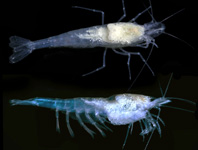Abstract
The new talitrid amphipod genus Hermesorchestia is established for one new species from Australia, H. alastairi, common to the beaches of Tasmania. Hermesorchestia gen. nov. is typified by the sexually dimorphic males which have palmate lobes on the carpus and propodus of gnathopod 1, a three dimensional merus article on pereopod 7 and expanded posterior margin of pereopod 7 carpus. Other characters which define H. alastairi gen. et sp. nov. are the male pereopod 6 expanded merus and carpus, pereopod 7 basis posterior expansion, merus shape both medial and facial, carpus posterior expansion and the shape and setation of the telson. Hermesorchestia alastairi gen. et sp. nov. is a documented burrower (sand-hopper), living in sand dunes above the high water mark.
References
Amano, T. & Sudo, S. (2013) Mechanical aspects in the relation between locomotive organs and behavior of beach flea. Journal of Aero Aqua Bio-mechanisms, 3 (1), 65–70.
https://doi.org/10.5226/jabmech.3.65
Bousfield, E.L. (1982) The amphipod superfamily Talitroidea in the northeastern Pacific region. 1. Family Talitridae: systematics and distributional ecology. National Museum of Natural Sciences (Ottawa), Publications in Biological Oceanography, 11, 1–73.
Bousfield, E.L. (1984) Recent advances in the systematics and biogeography of landhoppers (Amphipoda: Talitridae) of the Indo-Pacific Region. Bishop Museum Special Publication, 72, 171–210.
Bracht, G. (1980) The jump of Orchestia cavimana Heller, 1865 (Crustacea, Amphipoda, Talitridae). Experientia, 36 (1), 56–57.
https://doi.org/10.1007/BF02003968
Cothran, R.D., Stoler, A.B. & Relyea, R.A. (2014) Leaves and litterbugs: how litter quality affects amphipod life-history and sexually selected traits. Freshwater Science, 33 (3), 812–819.
https://doi.org/10.1086/677214
Daniel, M.J. (1982) Tui feeding on sandhoppers. Notornis, 29, 180.
Dugan, J.E. & Hubbard, D.M. (2006) Ecological responses to coastal armoring on exposed sandy beaches. Shore and Beach, 74 (1), 10–16.
Dugan J., Hubbard, D.M., McCrary, M.D. & Pierson, M.O. (2003) The response of macrofauna communities and shorebirds to macrophyte wrack subsidies on exposed sandy beach of southern California. Estuarine, Coastal and Shelf Science, 58, 25–40.
https://doi.org/10.1016/S0272-7714(03)00045-3
Egger, M. (1979) Varied thrushes feeding on talitrid amphipods. Auk, 96, 805.
Folmer, O., Black, M., Hoeh, W., Lutz, R. & Vrijenhoek, R. (1994) DNA primers for amplification of mitochondrial cytochrome C oxidase subunit I from diverse metazoan invertebrates. Molecular Marine Biology and Biotechnology, 3, 294–299.
Gibb, J. (1956) Food, feeding habits and territory of the rock pipit Anthus spinoletta. Ibis, 98, 506–530.
https://doi.org/10.1111/j.1474-919X.1956.tb01437.x
Griffiths, C.L. & Stenton-Dozey, J. (1981) The fauna and degradation of stranded kelp. Estuarine, Coastal and Shelf Science, 12, 645–653.
https://doi.org/10.1016/S0302-3524(81)80062-X
Griffiths, C.L., Stenton-Dozey, J. & Koop, K. (1983) Kelp wrack and the flow of energy through a sandy beach ecosystem. Sandy beaches as ecosystems. Springer.
Hall, T.A. (1999) BioEdit: a user-friendly biological sequence alignment editor and analysis program for Windows 95/98/NT. Nucleic Acids Symposium Series, 41, 95–98.
Haswell, W.A. (1879) On Australian Amphipoda. Proceedings of the Linnean Society of New South Wales, 4(3), 245–79, pls 7–12.
Hubbard, D.M. & Dugan, J.E. (2003) Shorebird use of an exposed sandy beach in southern California. Estuarine, Coastal and Shelf Science, 58S, 41–54.
https://doi.org/10.1016/S0272-7714(03)00048-9
Inglis, G. (1989) The colonisation and degradation of stranded Macrocystis pyrifera (L.) C. Ag. by the macrofauna of a New Zealand sandy beach. Journal of Experimental Marine Biology and Ecology, 125 (3), 203–217.
https://doi.org/10.1016/0022-0981(89)90097-X
Lastra, M., Page, H.M., Dugan, J.E., Hubbard, D.M. & Rodil, I.F. (2008) Processing of allochthonous macrophyte subsidies by sandy beach consumers: estimates of feeding rates and impacts on food resources. Marine Biology, 154, 163–174.
https://doi.org/10.1007/s00227-008-0913-3
Lowry, J.K. & Baldanzi, S. (2016) New talitrids from South Africa (Amphipoda, Senticaudata, Talitroidea, Talitridae) with notes on their ecology. Zootaxa, 4144 (2), 151–174.
https://doi.org/10.11646/zootaxa.4144.2.1
Lowry, J.K. & Coleman, C.O. (2011) Africorchestia a new genus of sand-hoppers (Crustacea: Amphipoda: Talitridae) from western Africa and south-western Europe. Zootaxa, 2825, 55–68.
Poore, A.G.B. & Gallagher, K.M. (2013) Strong consequences of diet choice in a talitrid amphipod consuming seagrass and algal wrack. Hydrobiologia, 701 (1), 117–127.
https://doi.org/10.1007/s10750-012-1263-1
Rafinesque, C.S. (1815) Analyse de la Nature ou Tableau de l'Univers. Aux dépens de l'auteur, Palerme, p. 224.
Richardson, A.M.M. (1993) Tasmanian intertidal Talitridae (Crustacea: Amphipoda). Palustral talitrids: two new species of Eorchestia Bousfield, 1984. Journal of Natural History, 27, 267–284.
https://doi.org/10.1080/00222939300770131
Richardson, A.M.M. (1996) Protorchestia lakei, new species (Amphipoda: Talitridae) from Maatsuyker Island, Tasmania, with a key to the genus and notes on the diversity of Tasmanian Talitridae. Journal of Crustacean Biology, 16, 574–583.
https://doi.org/10.1163/193724096X00612
Richardson, A.M.M. & Mulcahy, M.E. (1996) The distribution of talitrid amphipods (Crustacea) on a salt marsh in southern Tasmania, in relation to vegetation and substratum. Estuarine Coastal and Shelf Science, 43, 801–817.
https://doi.org/10.1006/ecss.1996.0104
Richardson, A.M.M., Swain, R. & Smith, S.J. (1991) Local distributions of sandhoppers and landhoppers (Crustacea: Amphipoda: Talitridae) in the coastal zone of western Tasmania. Hydrobiologia, 223, 127–140.
https://doi.org/10.1007/BF00047634
Richardson, A.M.M., Swain, R. & Wong, V. (1997) The crustacean and molluscan fauna of Tasmanian salt marshes. Papers and Proceedings of the Royal Society of Tasmania, 131, 21–30.
Schlacher, T.A., Carracher, L.K., Porch, N., Connolly, R.M., Olds, A.D., Gilby, B.L., Ekanayak, K.B., Maslo, B. & Weston, M.A. (2016) The early shorebird will catch fewer invertebrates on trampled sandy beaches. PLoS ONE, 11 (8), e0161905. https://doi.org/10.1371/journal.pone.0161905
Serejo, C.S. & Lowry, J.K. (2008) The Coastal Talitridae (Amphipoda: Talitroidea) of Southern and Western Australia, with Comments on Platorchestia platensis (Kroyer, 1845). Records of the Australian Museum, 60, 161–206.
https://doi.org/10.3853/j.0067-1975.60.2008.1491
Smith, S.I. (1874) The Crustacea of the freshwaters of the United States. A Synopsis of the higher freshwater Crustacea of the Northern United States, Appendix F. Natural History. Report of the Commissioner for 1872 and 1873. United States Commission of Fish and Fisheries, 2, 637–661.
Spence Bate, C.S. (1862) Catalogue of the Specimens of Amphipodous Crustacea in the Collection of the British Museum. In. Trustees, British Museum, London, p. 399.
Sudo, S. & Amano, T. (2014) Jump of Beach Flea and Its Biomimetic Jumping Mechanism. In Mechanical Engineering Congress, Japan, 9.7(10), article without pagination.
Vogel, F. (1985) Da Schwimmen der Talitridae (Crustacea, Amphipoda): Funktionsmorhologie, Phanomenologie und Energetik. Helgolander Meeresuntersuchungen, 39, 303–309.
https://doi.org/10.1007/BF01992776

